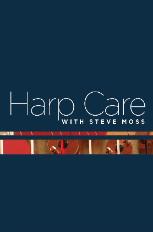
String ends can cause a sympathetic vibration when their tails are in contact with one another.
One of the most common and annoying harp buzzes is caused by unwanted vibrations where the strings are anchored in the soundboard. Fortunately this is also one of the easiest buzzes to eliminate. With a little patience and detective work, you can easily fix that annoying buzz yourself.
Have Some Sympathy.
You are probably already familiar with the concept of sympathetic vibrations, but if not, let me give an example. In your harp studio or practice room, have you ever had a light fixture or object nearby start buzzing every time you play a specific note? For some reason, that object is prone to vibrate at a particular frequency, and if your note matches, it will vibrate. If the vibrating object touches something else, it will cause a buzz, the same way a snare drum will sound when the band plays a particular note, even if no one is playing the drum. Depending on the thickness of the vibrating object and the acoustic properties of the room, the buzz may become loud enough to annoy the heck out of you.
A string end vibration is caused when the tail end of a string vibrates sympathetically with the note you are playing and the vibration causes it to come in contact with something else, usually a string anchor, another tail end, or the wood of the harp itself.
Since harps are designed to project sound, an unwanted buzz inside the body will be amplified and pushed right at your ear through the sound hole. The trick to eliminating it is to track down what two objects are touching one another and find a way to make them stop touching.
Diagnosing String End Vibrations
String end vibrations sound the loudest when you are sitting at the harp. To rule out noises coming from elsewhere, such as the action, play the buzzing string with your ear close to a soundhole, then with your ear close to the action. If the sound is louder at the soundhole, it is likely coming from inside the body, and the most likely culprit is a string end. Another common clue to a string end vibration is how many strings cause it. While most vibrations manifest in one particular string, some will occur in two or more adjacent strings, or in a single string in different pedal positions. In cases like this, the offending string end is so excitable it is vibrating along a range of frequencies.
It’s logical to think that if, for example, your harp buzzes when you play third octave C, that the problem is coming from that strings end, but this is rarely the case. Alas, it can be coming from practically any string end on the instrument. In most cases I’ve seen, though, it is probably coming from somewhere in the first through third octaves.
To locate a string end buzz, you can start by taking a look inside at where your strings are anchored. Can you see any places where two long string ends are touching one another, or where a long tail is able to brush against the soundboard? If so, carefully clip the tail shorter to see if you can stop the buzz.
If a visual inspection doesn’t do the trick, you need to play the offending note while using your other hand to push on each string end one at a time. If pressing against a particular string end stops the buzz, you’ve found your culprit. If not, keep trying. Press on each end more than once in slightly different places. You may need to hit some tiny little spot in order to stop the buzz. More than once I’ve checked every string and not found the source of the buzz, but then checked again and found it after another try, or even two more.
Once you find the location, try to determine what is likely to be buzzing. A string end that is very close to an anchor is a common one, as is a string end that is slightly long and touching wood. If you have a tail longer than the anchor, try to clip it shorter. If that doesn’t do the job, try rotating the string knot a quarter turn. Don’t overdo the rotating, as it can damage the string. In some cases, you can bend the tail so that it is farther from whatever it is in contact with.
If none of the fixes in the preceding paragraph work, and you are certain you are stopping the noise on this particular string, replace it. That should take care of the problem. Sometimes, there’s just something about the knot that is buzzing and there’s no way to fix it without starting over.
Not every buzz inside the harp’s body is a string end vibration. I have seen rib screws that were loose, braces that had come unglued, and handles that needed to be tightened. Once, we had a harp brought into Lyon & Healy to fix a bad buzz, and one of the technicians discovered that the problem was a ball point pen that had been clipped inside! However, over ninety-five percent of the buzzes you hear from this part of the harp are due to string end issues. It is well worth your time to try and eliminate them yourself instead of waiting months or a year for your technician. Happy hunting!


Thanks so much for this informative post, i’ve been worried with buzzes that come and go; so will give your solutions a try.
You’re welcome, Sonya! Hope they help.